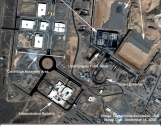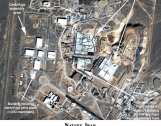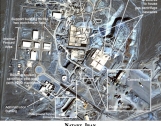Reports
The Iranian Gas Centrifuge Uranium Enrichment Plant at Natanz: Drawing from Commercial Satellite Images
by David Albright and Corey Hinderstein
March 14, 2003
Iran is building a high security uranium enrichment facility using gas centrifuges near Natanz. This site is about 40 kilometers southeast of Kashan and about 150 kilometers north of Isfahan. The IAEA has characterized the centrifuges at this site as sophisticated and the culmination of a large, expensive effort.
Iran has demonstrated a capability possessed by only about ten countries. Because of the characteristics of gas centrifuges, the Iranian facility could be used for the production of low enriched uranium for civil purposes or highly enriched uranium for nuclear weapons, depending on the decision of the Iranian government.
An Iranian opposition group first revealed publicly the existence of this site in August 2002. Using the crude geographical information from this group and the archives of commercial imaging firm Digital Globe, ISIS found an image of the Natanz site taken on September 16, 2002. ISIS released the first public images of this site in December 2002. Subsequently, ISIS obtained a February 7, 2002 image of this site from Digital Globe. By assessing these images and using information from other sources, a more complete understanding can be gained of the Natanz site. This assessment remains preliminary and will be updated as more information becomes available.
The Natanz site is surrounded by a security fence and has many buildings, including underground facilities, representing a large uranium enrichment complex. Underground buildings currently under construction will be devoted to enriching uranium, and these well-protected buildings are sized to hold over 50,000 centrifuges.
Because of the nature of this site, a large military strike would be necessary to destroy these undergound buildings. Other information about Iran’s centrifuge program suggests that even if the Natanz site was destroyed militarily, Iran’s decentralized gas centrifuge program could not be bombed out of existence, meaning that Iran could relative rapidly build a small gas centrifuge facility that would be extremely difficult to detect.
The site contains at least three main areas, which are:
Iran has made significant progress at the site between September 2002 and February 2003. Change is particularly visible at the large underground structures described in detail below. The smaller underground building now appears to have a roof. New small buildings are visible in the second image, and other buildings are more complete. Roads have new paving.
According to media reports, the site is many years from being completed. Iran, however, may start enriching significant quantities of uranium in centrifuges long before the plant is completed. It could produce significant quantities of enriched uranium either in the pilot plant or underground, perhaps as soon as next year. Small quantities of uranium could be enriched at any time in the pilot plant.
The Underground Structures: Main Enrichment Halls and Support Facilities
Each of the two largest underground structures have horizontal dimensions of about 190 meters by 170 meters, with a gross area of approximately 32,000 square meters each. The smaller structure, situated adjacent to both large structures has a gross ground area of approximately 7,700 square meters.
When completed, the two largest underground structures are designed to be the main buildings for the production of enriched uranium in gas centrifuges, commonly called cascade halls. Their large floor area implies that Iran intends to install tens of thousands of centrifuges (see analysis below).
The September image (see figure 1) shows that these halls have very thick walls. Media reports, quoting US government sources, give the thickness of the walls as over two meters. The February image (see figure 2) shows progress in the construction of these massive buildings. They are not finished, however. What appears to be the roofs of these underground structures do not appear complete. In addition, there are on-going construction activities on the roofs of these buildings, involving cranes, cement and dump trucks, and a large number of pipes awaiting installation (see figure 3).
Some of the roof structures appear to rise above ground level. Whether additional structures will be built on top of these roofs or the structures will be simply covered with dirt remains unclear.
The smaller underground structure will provide services to the two larger buildings. In the February image, the roof of this building appears to almost cover its entire internal structure, which can be seen in the September image.
The images show several access roads into the underground structures. The September image shows more clearly a road leading down to underground construction. In the February image, this road now appears to be largely underground. Its entrance is marked on the second image.
In this same area, several other underground structures are visible in the September image (marked by X’s on figure 1) whose purposes are not identified. The existence of other structures is not unexpected at such a large enrichment plant. Additional storage sites for materials are needed. Buildings are also needed for handling fresh and exhaust air, electricity and water supplies.
The most likely reason for building an enrichment plant underground is to enable it to withstand aerial attack. The shape of the vehicle entrance tunnel, which appears to provide protection against a direct bomb or glide bomb hit on the plant itself, further supports this conclusion.
White-Roofed Structures: Centrifuge Assembly Facility and Pilot Plant
The aboveground structures in this area are contained within a high-security enclosure (see figures 1 and 4). All buildings appear to be well contained, without roof exits, exhausts or skylight windows (except in the entrance areas). Each building has its own entrance area, contained in a bulge. Two of the buildings (marked 1 on figure 1) appear to be copies of each other. The other buildings look similar, but are different in areas and in the location of the bulge relative to the main structure. Every two buildings have separate air-conditioning systems (marked 6 on figure 1). This structures appear more finished in the February image.
The role of this complex is to test and assemble gas centrifuges using components that are made at other sites. Iran is reported to have a network of companies or government-owned entities that make the necessary centrifuge components. In addition, the headquarters of the centrifuge program is not located at Natanz, and Iran maintains other sites where it conducts tests of single machines.
The assembly facility contains an extensive assortment of equipment to test individual components and to test and assemble whole centrifuges, a complicated process. This area also includes a quality control laboratory and a pilot centrifuge plant (marked 5 on figure 1).
The pilot centrifuge plant contained about 160 centrifuges operating in a cascade when senior IAEA officials visited the site on February 21, 2003. No uranium, however, was in any of the centrifuges at this site when these IAEA officials visited. The IAEA officials also saw components for another 1000 centrifuges in these buildings.
Administration Building
In the image, a relatively large building appears complete. It is an administration building for the site. It may also house other support functions.
Other Buildings
The site contains many other buildings. However, functions cannot be currently assigned to these many smaller or less distinct buildings.
Uranium hexafluoride for the gas centrifuges will not be produced on this site. According to Iranian government statements, uranium hexafluoride will be produced at the uranium conversion facility at Isfahan and shipped to the Natanz site. The uranium conversion facility is expected to open soon and produce its first uranium hexafluoride by the end of 2003. This material would likely enter the enrichment halls through an underground vehicle entrance.
Estimated Enrichment Capacity of the Natanz Site
As mentioned above, the two underground structures have a combined area of over 60,000 square meters, implying a substantial floor area for centrifuges. Such a large facility is intended to hold tens of thousands of centrifuges and is consistent with Iranian government statements that it wants to produce low enriched uranium for nuclear power reactors. However, such a large facility could also be used to make highly enriched uranium for nuclear weapons. Iran could also secretly possess or build another, much smaller facility to make highly enriched uranium.
The Iranian government has announced that over the next 20 years it wants to build several nuclear power reactors for a total capacity of 6,000 megawatts of electricity. Tehran has also stated that it wants to be self-sufficient in the nuclear area, implying that it wants to produce the low enriched uranium it would need for at least some of these reactors. It does not appear to want to produce all its low enriched uranium fuel. For example, it has announced that it will buy low enriched uranium from Russia for the Bushehr power reactor that Russia is providing.
To be fully self-sufficient in the production of low enriched uranium for an installed capacity of 6,000 megawatts of electricity, Iran would need an enrichment capacity of about 600,000 separative work units (SWU) each year. The two underground structures at Natanz do not appear large enough to achieve this enrichment capacity, but Iran may be trying to provide a significant fraction of this anticipated capacity over the next two decades. Based on a combined surface area of about 60,000 square meters, these enrichment halls are crudely estimated to be able to hold about 50,000 centrifuges, where each centrifuge requires on average roughly one square meter of floor space. Substantially more centrifuges could be located in the halls, particularly if the centrifuges are packed more tightly or stacked vertically. If each centrifuge has an enrichment capacity of up to 5 SWU per year, the total capacity of this facility when finished is estimated to be up to 250,000 SWU per year. This is a rough estimate that reflects extensive uncertainties about both the underground structures and Iran’s centrifuges. In addition, advanced countries, such as Japan, have encountered difficulties in building reliable centrifuges on such a large scale, meaning that Iran may fail in its bid to build such a large centrifuge plant.
This capacity is far larger than needed for a nuclear weapon program, supporting Iran’s statement that the facility is aimed at producing low enriched uranium for nuclear power reactors. Nonetheless, such a facility could use a relatively small fraction of its capacity, say 10,000 SWU per year, to make enough highly enriched uranium for three nuclear weapons a year, while using the remaining capacity to produce low enriched uranium. In addition, if a country can make an enrichment plant of this size, it can make enough machines to outfit another secret enrichment plant with a capacity of 10,000 SWU per year involving several thousand machines. IAEA safeguards could detect such clandestine activities, but the IAEA must have far more extensive inspection rights than Iran has been willing to provide the IAEA so far.
Recent media reports have stated that Natanz is intended to house only 5,000 centrifuges. This number may reflect an interim goal for this site, perhaps the capacity Iran wants to achieve in the next few years.
For more information about gas centrifuge technology, including diagrams and photos, click here.





 twitter
twitter